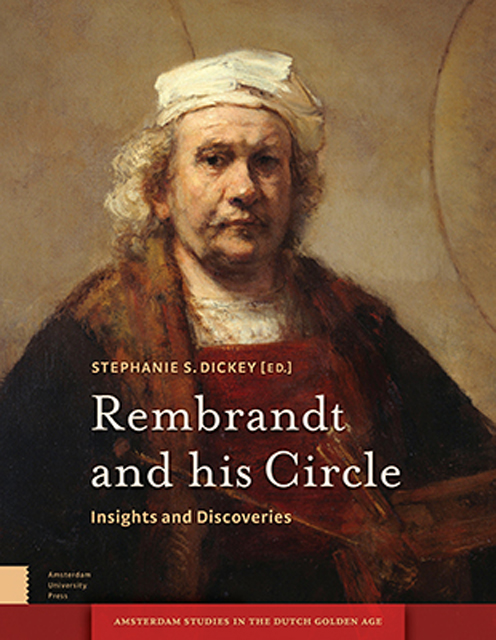Book contents
- Frontmatter
- Dedication
- Contents
- Acknowledgements
- Introduction
- 1 Rembrandt and Frans Hals Painting in the Workshop of Hendrick Uylenburgh
- 2 Rembrandt and the Germanic Style
- 3 Rembrandt and the Humanist Ideal of the Universal Painter
- 4 Curiosity and Desire: Rembrandt’s Collection as Historiographic Barometer
- 5 Painted Landscapes by Lievens and Rembrandt : The View from Seventeenth-Century Amsterdam Collections
- 6 Jan Lievens in Antwerp: Three Rediscovered Works
- 7 Gerrit Dou as a Pupil of Rembrandt
- 8 A New Painting by Jan van Noordt in Budapest
- 9 Rembrandt’s First Nude? The Recent Analysis of Susanna and the Elders from Rembrandt’s Workshop
- 10 Rembrandt’s Head of Christ: Some Technical Observations concerning Matters of Style
- 11 A Rediscovered Head of John the Baptist on a Platter from Rembrandt’s Studio
- 12 Rembrandt’s One Guilder Print: Value and Invention in ‘the most beautiful [print] that ever came from the burin of this Master’
- 13 Rembrandt, Ferdinand Bol, and Tobit: The Emergence of a Pathosträger
- 14 Biblical Iconography in the Graphic Work of Rembrandt’s Circle
- 15 Jan van Vliet and Rembrandt van Rijn: Their Collaboration Reassessed
- 16 Printmaking among Artists of the Rembrandt School
- 17 Chain Line Pattern Matching and Rembrandt’s Prints
- List of Illustrations
- Bibliography
- Index Nominum
6 - Jan Lievens in Antwerp: Three Rediscovered Works
Published online by Cambridge University Press: 21 January 2023
- Frontmatter
- Dedication
- Contents
- Acknowledgements
- Introduction
- 1 Rembrandt and Frans Hals Painting in the Workshop of Hendrick Uylenburgh
- 2 Rembrandt and the Germanic Style
- 3 Rembrandt and the Humanist Ideal of the Universal Painter
- 4 Curiosity and Desire: Rembrandt’s Collection as Historiographic Barometer
- 5 Painted Landscapes by Lievens and Rembrandt : The View from Seventeenth-Century Amsterdam Collections
- 6 Jan Lievens in Antwerp: Three Rediscovered Works
- 7 Gerrit Dou as a Pupil of Rembrandt
- 8 A New Painting by Jan van Noordt in Budapest
- 9 Rembrandt’s First Nude? The Recent Analysis of Susanna and the Elders from Rembrandt’s Workshop
- 10 Rembrandt’s Head of Christ: Some Technical Observations concerning Matters of Style
- 11 A Rediscovered Head of John the Baptist on a Platter from Rembrandt’s Studio
- 12 Rembrandt’s One Guilder Print: Value and Invention in ‘the most beautiful [print] that ever came from the burin of this Master’
- 13 Rembrandt, Ferdinand Bol, and Tobit: The Emergence of a Pathosträger
- 14 Biblical Iconography in the Graphic Work of Rembrandt’s Circle
- 15 Jan van Vliet and Rembrandt van Rijn: Their Collaboration Reassessed
- 16 Printmaking among Artists of the Rembrandt School
- 17 Chain Line Pattern Matching and Rembrandt’s Prints
- List of Illustrations
- Bibliography
- Index Nominum
Summary
Abstract
This essay presents three works that have recently come to light and attributes them to Jan Lievens based on stylistic analysis and relationship to reproductive prints. One is a woodcut related to the portrait of the Jesuit artist Daniel Seghers etched by Paul Pontius after a drawing by Lievens. Two are paintings recently on the art market: Virgin and Child with a Pear, reproduced in an etching by Lievens himself, and Drinker Holding a Glass and Pitcher, interpreted in a print by Anthonie van der Does. All are dated to Lievens's years in Antwerp (1635–1644), where he belonged to a network of artists that included Anthony van Dyck and Adriaen Brouwer. Lievens's activities in Antwerp testify to the close interactions that persisted among artists across the political divide and suggest a conduit for artistic exchange between Flemish masters and Dutch artists in Rembrandt's circle.
Keywords: Jan Lievens, Daniel Seghers, Anthony van Dyck, Paul Pontius, Adriaen Brouwer, Joos van Craesbeeck, etching, woodcut, Antwerp
In 1635, Jan Lievens settled in Antwerp, where he joined the Guild of St. Luke and quickly immersed himself in a lively community of painters and printmakers. This was the third stop in a peripatetic career that began in Leiden and ended in Amsterdam. Scholarly attention to Lievens has long focused on his formative years and his personal and stylistic association in Leiden with Rembrandt van Rijn. However, in the wake of the major exhibition of Lievens's paintings, prints, and drawings held in Washington, Milwaukee, and Amsterdam in 2008-2009, awareness of his later development has grown, and lost works from all periods of his career have resurfaced. The present essay focuses on several recent discoveries that shed light on Lievens's Antwerp period (1635–1644). The works discussed here have been overlooked until now because they were tucked away out of sight, and because so little attention has been paid to Lievens's activities in Antwerp. Together they demonstrate the breadth of Lievens's production in Flanders and the close interaction of paintings and prints both in his own work and in the milieu to which he belonged.
- Type
- Chapter
- Information
- Rembrandt and his CircleInsights and Discoveries, pp. 151 - 168Publisher: Amsterdam University PressPrint publication year: 2017

